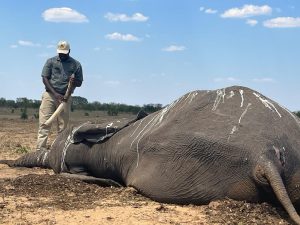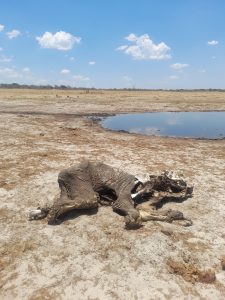

A PUTRID stench fills the air as decomposing elephant carcasses attract swarms of feasting flies and vultures. Nearby, a dwindling waterhole serves as a lifeline for the parched wildlife of Hwange National Park, Zimbabwe’s largest national park.
Hwange National Park, a sprawling expanse spanning 14 650 square kilometres, stands as a testament to the harsh realities of climate change. With a burgeoning elephant population reaching 65 000, the park’s wildlife management authority finds itself unable to fully address the escalating crisis.
Zimbabwe National Parks and Wildlife Management Authority (Zimparks) principal ecologist at Hwange National Park, Daphne Madhlamoto, paints a bleak picture of the struggle against the relentless onslaught of climate change.
“We have been receiving less rainfall over the years. We are also experiencing high temperatures, up to 43 degrees Celsius. The frequency of droughts has increased over time,” she told this publication. Elephants drink about 200 litres of water a day, and the dry spell has resulted in their succumbing to dehydration.

With a burgeoning elephant population reaching 65 000, Hwange National park’s wildlife management authority finds itself unable to fully address the escalating crisis.
“The park doesn’t have a major river. We rely on artificial supplies. Currently, we are pumping nearly 104 boreholes using solar. With the impacts of climate change, our surface water has declined, so at most of our water pans, there is competition for water amongst the wildlife, with elephants dominating the pans,” Madhlamoto said.
Zimparks spokesperson, Tinashe Farawo, said the park has been recording several elephant deaths due to extreme temperatures.
“As the dry spell continues, young, ill and elderly elephants are most affected as they are unable to travel long distances, in search of water and food, some got stuck near water holes, foraging all plants within their range,” he said.
An elephant was found stuck in the mud this morning in Hwange. pic.twitter.com/a378DUSOxj
— Tinashe Farawo (@FarawoTinashe) November 28, 2023
As global policymakers convened in Dubai for COP28, conservationists have called for negotiators to prioritise wildlife as a critical component in fighting climate change. The UN climate summit has a day dedicated to nature, land use and oceans.
The International Fund for Animal Welfare (IFAW) Zimbabwe field operations manager Arnold Tshipha said his organisation is pursuing an ambitious initiative — the room-to-roam project — for conservation purposes.

Elephants drink about 200 litres of water a day, and the dry spell has resulted in their succumbing to dehydration.
“The room-to-roam initiative focuses on building climate-resilient landscapes to ensure that people and wildfire can thrive together. “This is largely done through the leveraging of the power of climate-smart conservation, landscape restoration, promoting carbon capture, and supporting the community that surrounds the several landscapes where we operate,” he said.
“Wildlife is a critical component in climate change response, and a good example is the elephants that we have in abundance at Hwange National Park. Elephants help maintain carbon storage capacities in their ecosystems and promote plant growth by breaking down trees, trampling and scuffing soils, and cycling carbon through the landscape as they digest and deposit plant matter,” Tshipha said.
IFAW says temperature rises pose a serious and rapidly accelerating threat to the health of the planet and the lives of animal and plant species around the world. Through the Paris Agreement, nations agreed that global warming should not exceed 1.5 degrees Celsius if the worst impacts of climate change are to be avoided.
Zimbabwe has the second largest elephant population in the world, as well as a sizeable black rhinoceros population, according to the World Wide Fund for Nature.